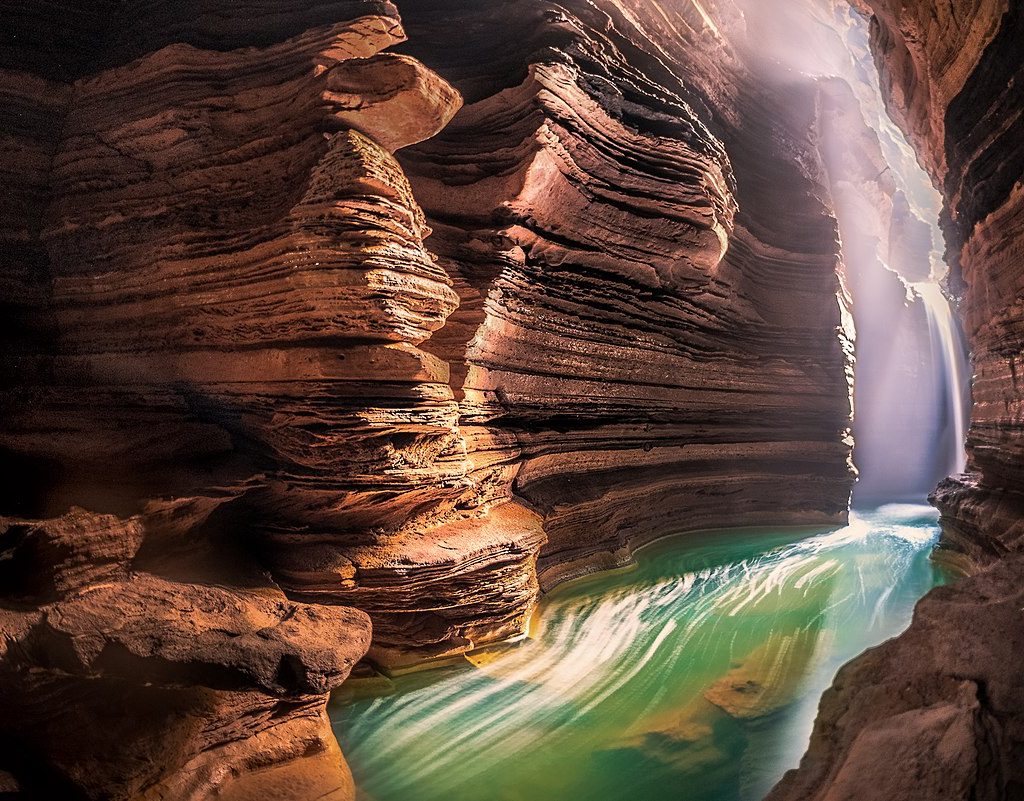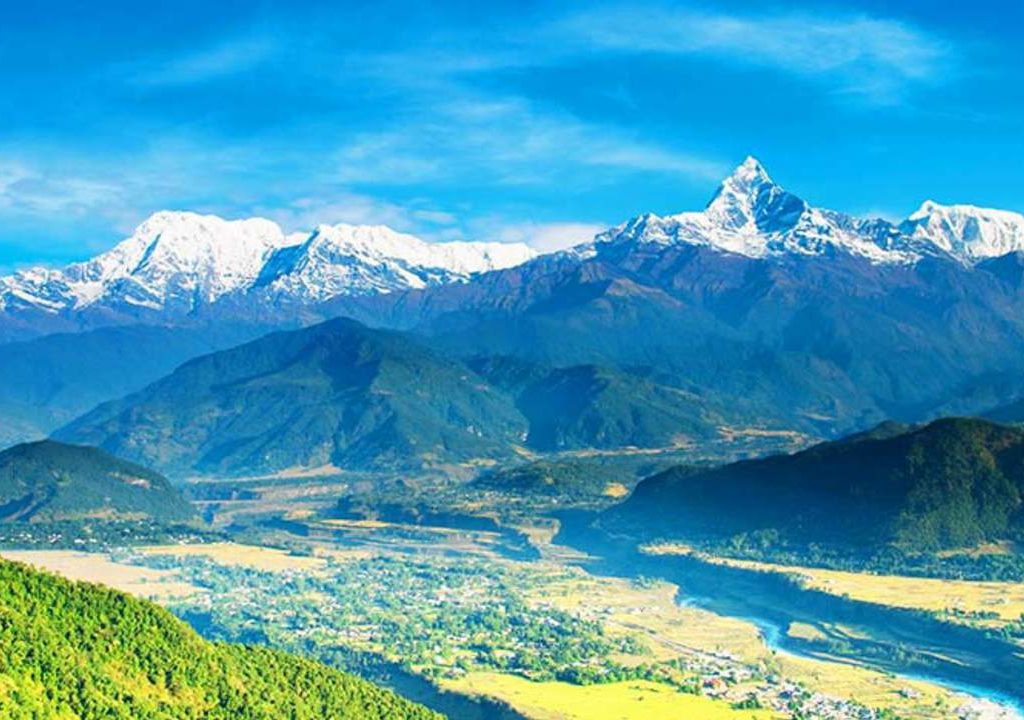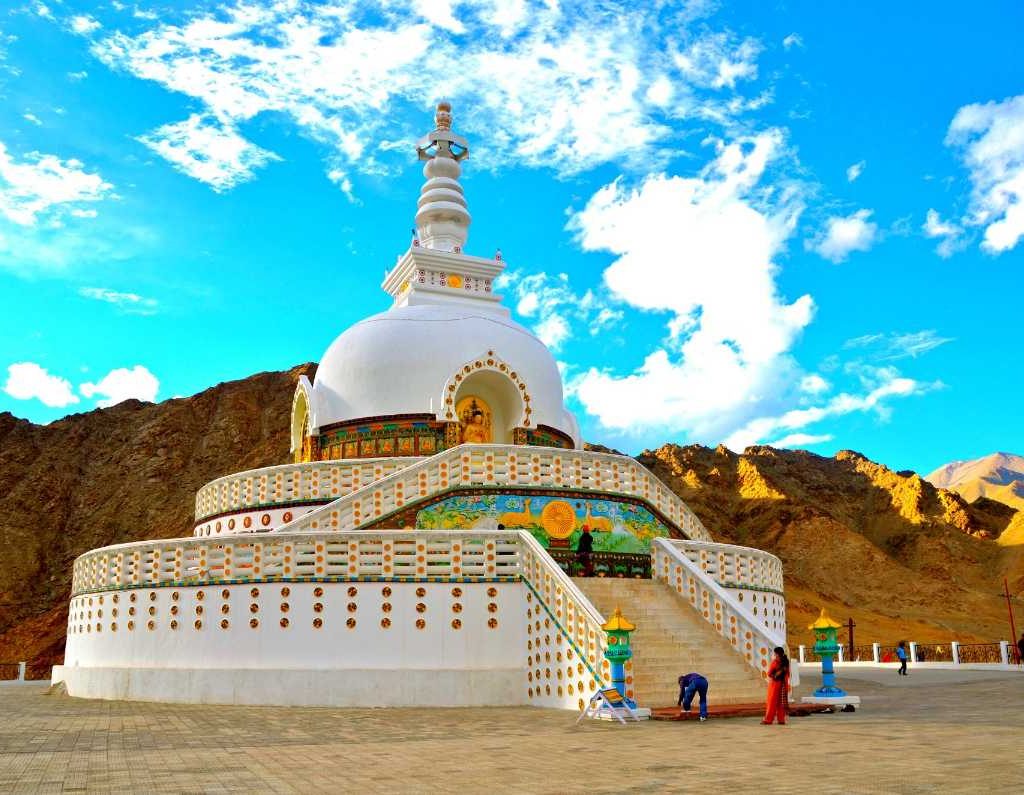POKHARA
Pokhara, located about 200 km west of Kathmandu, is Nepal’s tourism capital and the main gateway to the Annapurna trekking region. Set at an elevation of 827 meters, the city enjoys a mild climate and stunning natural beauty.
What sets Pokhara apart is its unique setting—it’s one of the few places where massive peaks like Annapurna, Dhaulagiri, and Machhapuchhre can be viewed up close from such a low altitude. These majestic mountains frame the lush valley and serene lakes, offering breathtaking scenery.
The city is centered around Phewa Lake, where visitors can enjoy boat rides, visit Tal Barahi Temple, or admire Himalayan reflections on the water. Pokhara is also a top destination for adventure sports like paragliding, bungee jumping, zip-lining, and ultra-light flights.
Culturally rich and diverse, Pokhara features temples, stupas, local markets, and festivals that showcase Nepal’s traditions. The vibrant Lakeside area is a favorite among tourists for its shops, restaurants, and lively atmosphere, especially in the evenings.
Whether you seek adventure, peace, or cultural discovery, Pokhara offers something for everyone, making it one of Nepal’s most cherished destinations.
Top Places to Visit in Pokhara
1. Phewa Lake
The second-largest lake in Nepal, ideal for boating, relaxation, and viewing reflections of the surrounding mountains. The lake also houses a small island with Tal Barahi Temple.
2. Tal Barahi Temple
Located in the center of Phewa Lake, this Hindu temple is accessible by boat and is dedicated to Goddess Durga.
3. Sarangkot
A popular viewpoint for observing sunrise and mountain ranges including Annapurna and Machhapuchhre. Sarangkot is also a top spot for paragliding.
4. Devi’s Fall
Also known as David’s Falls, this waterfall flows directly into an underground tunnel and is best viewed during the monsoon season.
5. Gupteshwor Mahadev Cave
Located near Devi’s Fall, this limestone cave features a sacred Shiva Lingam and underground pathways.
6. Bindabasini Temple
One of the oldest temples in Pokhara, located on a small hill. It is dedicated to Goddess Durga and offers views of the surrounding area.
7. Shanti Stupa (World Peace Pagoda)
A Buddhist monument located on a hilltop overlooking Pokhara. It provides panoramic views of the city, lakes, and mountains.
8. Begnas Lake
A quieter and less crowded lake, ideal for peaceful boating, picnics, and enjoying nature.
9. Mahendra Cave
A natural cave with stalactites and stalagmites, known for its religious significance and exploration appeal.
10. International Mountain Museum
This museum offers detailed information about mountaineering, Himalayan expeditions, and the culture of mountain communities.
1. Phewa Lake:-

Phewa Lake, also known as Fewa Lake, is one of the most iconic tourist attractions in Pokhara, Nepal. Spanning approximately 4.4 square kilometers, it is the second-largest lake in Nepal and a centerpiece of natural beauty and serenity in the region. Surrounded by lush green hills and the majestic Annapurna mountain range, the lake offers a spectacular setting that captures the essence of Pokhara’s charm.
Scenic Beauty and Atmosphere
The lake’s calm, mirror-like surface beautifully reflects the snow-capped peaks—especially Machhapuchhre (Fishtail Mountain)—creating picture-perfect views. Whether early in the morning or during sunset, the scenery is captivating, offering a peaceful retreat from the busy pace of urban life. The lake’s tranquil atmosphere makes it an ideal destination for those seeking relaxation and a connection with nature.
Activities Around the Lake
Phewa Lake provides a variety of recreational options for visitors:
- Boating: Rent a traditional wooden boat or paddle yourself across the still waters.
- Kayaking & Fishing: Adventurous options are also available for water sports lovers.
- Lakeside Walks: The well-maintained walking trails around the lake are perfect for leisurely strolls.
- Island Visit: In the center of the lake lies the Tal Barahi Temple, a two-story pagoda-style temple dedicated to the Hindu goddess Barahi. It is accessible by boat and is one of Pokhara’s spiritual landmarks.
Local Life and Culture
The Lakeside area, lining the eastern shore of Phewa Lake, is a vibrant zone filled with cafes, restaurants, souvenir shops, and hotels. Tourists can enjoy local cuisine, shop for handmade crafts, or simply relax with a lakeside coffee while taking in the view. It’s also a great place to interact with locals and experience Pokhara’s friendly hospitality and diverse culture.
Why Visit Phewa Lake?
Phewa Lake is more than just a scenic attraction—it is a blend of natural beauty, cultural importance, and recreational enjoyment. Whether you’re looking to enjoy a peaceful afternoon boat ride, explore spiritual sites, or immerse yourself in local life, Phewa Lake offers something for every kind of traveler.
2. Talbarai Temple:-

Tal Barahi Temple is a revered Hindu temple located on a small island in the center of Phewa Lake, making it one of the most iconic and visually striking landmarks in Pokhara, Nepal. Surrounded by calm waters and the scenic beauty of green hills and distant mountains, the temple draws both pilgrims and tourists seeking spiritual depth and peaceful scenery.
Spiritual Significance
The temple is dedicated to Goddess Durga, a powerful Hindu deity known for protecting the universe from evil forces. The main shrine features a two-story pagoda-style architecture, showcasing traditional Nepali craftsmanship. The goddess is portrayed with multiple arms, each holding symbolic weapons, and is adorned with vibrant jewelry and offerings from devotees. Alongside the main sanctum, there are smaller shrines honoring other Hindu gods and goddesses, adding to the site’s spiritual depth.
A Journey Across the Water
Reaching the temple involves a short and peaceful boat ride across Phewa Lake. This short trip offers visitors a unique chance to enjoy the beauty of the lake while approaching the temple that seems to float gently on the water. The experience is as spiritual as it is scenic.
Cultural Immersion
Upon arrival, visitors can explore the detailed architecture, observe daily prayers and offerings, and witness the deep religious traditions practiced by local devotees. The temple is especially lively during festivals and religious ceremonies, where chants, flowers, and incense fill the air with devotion and cultural vibrancy.
A Must-Visit Experience
Tal Barahi Temple offers more than just religious significance. It provides:
- A serene atmosphere amidst the lake.
- Rich cultural experiences through rituals and traditions.
- Breathtaking views of the lake, hills, and distant peaks.
Whether you’re spiritually inclined or simply seeking a peaceful and culturally rich spot to explore, Tal Barahi Temple offers a truly memorable experience reflecting Pokhara’s spiritual heart.
3. Mahendra Cave

Mahendra Cave, also known locally as the Bat Cave, is a remarkable natural limestone cave located in Pokhara, Nepal. Named after King Mahendra Bir Bikram Shah Dev, who visited the site in the 1950s, this cave has become one of Pokhara’s most intriguing and adventurous tourist attractions.
Location and Accessibility
Situated just 2.5 kilometers from Pokhara Airport, Mahendra Cave is easily reachable by taxi, motorbike, or public transport. Its convenient location makes it a perfect half-day trip for both domestic and international tourists looking to explore Pokhara’s underground beauty.
Exploring the Depths
The cave stretches around 150 meters in length, beginning with a narrow, rocky entrance that leads into a surprisingly large chamber. Inside, visitors are greeted by impressive formations of stalactites and stalagmites, naturally sculpted over millions of years. The cave is also home to a colony of bats, which adds to its wild and mysterious vibe.
Due to the absence of electric lighting inside, flashlights or headlamps are necessary for navigating the dark and slippery paths, creating an authentic cave exploration experience.
Geological and Natural Significance
Believed to be millions of years old, Mahendra Cave is of great geological importance, showcasing the raw and ancient beauty of Nepal’s limestone formations. The interior remains cool and humid year-round, offering a refreshing retreat from the warmer temperatures outside.
Visitor Amenities
Near the cave entrance, you’ll find souvenir shops, snack stalls, and small eateries, making it easy to grab a quick bite or pick up handcrafted mementos. The cave is open daily from early morning to late afternoon, with an affordable entry fee that supports site maintenance and tourism development.
Why Visit Mahendra Cave?
If you’re looking for something different in Pokhara—something more thrilling and raw—Mahendra Cave delivers:
- A natural underground adventure with real cave exploration.
- Insights into Nepal’s ancient geological landscape.
- A chance to experience local folklore and natural mystery.
Whether you’re a nature lover, geology enthusiast, or curious explorer, Mahendra Cave offers a fascinating underground journey that shouldn’t be missed.
4. David Falls: –

Devi’s Fall, also locally known as Patale Chhango, is one of the most fascinating and iconic natural attractions in Pokhara, Nepal. This stunning waterfall captivates visitors with its powerful beauty and the intriguing story behind its name.
The Legend Behind the Name
Devi’s Fall earned its name from a tragic event. According to local legend, a Swiss woman named Devi was swept away by the waterfall while bathing in the river above it. Her body was later recovered in the underground tunnel system that the waterfall disappears into. To honor her memory, the site was named Devi’s Fall, symbolizing both beauty and sorrow.
Nature’s Underground Escape
The most unique feature of Devi’s Fall is that the water from the Pardi Khola (river) suddenly vanishes into an underground tunnel, creating a deep and narrow gorge below. During the monsoon season, the volume of water increases dramatically, making the fall even more spectacular and thunderous.
The waterfall plunges into a mysterious cave system beneath the surface, adding a mystical quality to the site. Just across from the fall lies the entrance to Gupteshwor Cave, where the waterfall re-emerges and can be seen from below—a unique connection between two of Pokhara’s popular destinations.
Scenic Viewpoints and Photography
The area around Devi’s Fall is beautifully landscaped with walking paths, gardens, and viewing platforms that offer great angles for photos. The powerful water crashing into the rocky gorge, surrounded by lush greenery, makes it a perfect backdrop for nature and travel photography.
Visitor Facilities
Devi’s Fall is located just a few kilometers from the main city and is easily accessible by taxi or local transport. The site includes:
- Well-maintained walkways
- Stone sculptures and local art installations
- Small shops and local stalls for souvenirs and refreshments
A Must-See in Pokhara
Whether you’re a nature enthusiast, a photography lover, or simply exploring Pokhara’s wonders, Devi’s Fall is a spot you shouldn’t miss. It offers:
A unique connection to the underground Gupteshwor Cave
A powerful natural display with an emotional backstory
Breathtaking views and scenic surroundings
5. Gupteshwor Cave:-

Gupteshwor Cave is one of Pokhara’s most captivating natural attractions, blending awe-inspiring geology with deep spiritual significance. Located just across from Devi’s Fall, this cave is not only a natural wonder, but also a revered pilgrimage site that draws thousands of visitors every year.
A Hidden World Beneath the Surface
Step into a mystical world carved by nature over thousands of years. The cave is renowned for its stunning stalactite and stalagmite formations, creating an underground landscape that feels otherworldly. As you descend deeper into the cave, you’ll encounter a breathtaking underground waterfall—the very continuation of Devi’s Fall—crashing through the rocks and echoing through the chamber with raw, natural power.
A Place of Spiritual Peace
More than just a geological gem, Gupteshwor Cave is a sacred site for followers of Hinduism. The cave is home to a revered Shivalinga, dedicated to Lord Shiva, one of the principal deities in Hindu mythology. Pilgrims and spiritual seekers visit the cave to offer prayers and experience the serene, spiritually charged atmosphere within its cool, dimly lit walls.
Accessibility and Experience
Located just a few kilometers from the heart of Pokhara, Gupteshwor Cave is easy to reach by local transport or taxi. Inside, paved paths and hand railings make the descent into the cave safer and more comfortable for visitors. The deeper you go, the more magical it feels—especially when you reach the hidden waterfall chamber, where the sound of cascading water mixes with the peaceful hum of prayers.
Outside the cave, visitors can explore:
- Local souvenir shops
- Religious items for offerings
- Snack stalls and resting areas
Why Visit Gupteshwor Cave?
Whether you’re a nature lover, a spiritual seeker, or simply an adventurer looking to explore Pokhara’s hidden treasures, Gupteshwor Cave offers an unforgettable experience:
A perfect blend of mythology, mystery, and nature
A rare underground waterfall linked to Devi’s Fall
A sacred temple of Lord Shiva deep inside the earth
A natural limestone cave formed over thousands of years
6. Bindabasini Temple:-

Nestled in the heart of Pokhara, Bindabasini Temple stands as a serene and sacred destination where spirituality and tradition come together in perfect harmony. Dedicated to Goddess Durga, worshipped here as Bindabasini, this temple holds deep religious and cultural significance for both locals and pilgrims alike.
A Divine Seat of Devotion
The temple is a spiritual haven where countless devotees gather to seek blessings and offer prayers. As you approach the temple, the atmosphere becomes infused with the soothing sounds of devotional chants and temple bells, creating an aura of peace and reverence. The spiritually charged ambiance invites visitors to pause, reflect, and connect with the divine.
A Glimpse of Traditional Beauty
Inside the temple, you’ll be captivated by the sight of the idol of Goddess Bindabasini, adorned in vibrant attire and shimmering jewelry, radiating strength and grace. The temple’s architecture is a stunning blend of traditional Nepali craftsmanship and Hindu aesthetics, featuring a classic pagoda-style structure, intricate woodwork, and symbolic carvings.
A Place of Cultural Significance
Bindabasini Temple is not just a religious site; it’s a cultural landmark of Pokhara. Many local rituals, festivals, and celebrations revolve around this temple, especially during Dashain, when thousands of devotees gather to pay homage to the goddess. The temple also offers panoramic views of the Annapurna range and the surrounding city, making it a favorite spot for both spiritual seekers and photography enthusiasts.
Easy to Access, Hard to Forget
Conveniently located within Pokhara city, the temple is easily accessible via taxi or local transport. Whether you visit in the early morning hours to hear the rhythmic bells or during festival times when the temple comes alive with color and devotion, Bindabasini Temple promises an experience that stays with you.
Why Visit Bindabasini Temple?
Beautiful surroundings with views of mountains and Pokhara Valley
A sacred place to experience authentic Hindu rituals
A stunning example of traditional Nepali architecture
A peaceful retreat in the middle of the city
7. Sarangkot:-

Perched atop a serene hill in the outskirts of Pokhara, Sarangkot is more than just a viewpoint—it is a sacred retreat where natural beauty and spiritual energy blend seamlessly. Offering breathtaking panoramic views of the Himalayan range, including Annapurna, Dhaulagiri, and Machhapuchhre (Fishtail), Sarangkot is a place where the soul finds peace and perspective.
A Divine Escape into the Hills
Sarangkot is often described as a spiritual sanctuary, where the calm of nature nurtures inner stillness. For centuries, this hilltop has drawn sages, pilgrims, and seekers who come in search of clarity, wisdom, and a deeper connection to the divine. Many believe that this sacred space has been blessed by deities, making it a revered location for meditation and quiet contemplation.
An Unmatched Sunrise Experience
One of Sarangkot’s most iconic attractions is its spectacular sunrise view. As the first light of dawn touches the snow-covered peaks, the entire horizon comes alive with golden hues. The gentle chime of temple bells and the soft echo of devotional chants in the distance enhance the spiritual ambiance, making sunrise at Sarangkot a deeply moving experience.
Rich in Cultural and Religious Significance
Sarangkot is not only a haven for nature lovers but also a respected pilgrimage site for both Hindus and Buddhists. The ancient temples nestled along the ridgeline reflect the area’s cultural depth and spiritual importance. Visitors often find themselves immersed in the tranquil rhythms of local rituals and traditions, which have been preserved for generations.
A Destination Beyond the Ordinary
Whether you come to Sarangkot for spiritual reflection, photography, or simply to experience the grandeur of the Himalayas up close, the journey leaves a lasting impression. Surrounded by lush green valleys, traditional villages, and timeless mountain landscapes, Sarangkot stands as a reminder of Nepal’s natural and spiritual richness.
Why Visit Sarangkot?
Peaceful retreat just a short drive from Pokhara
Panoramic views of the Himalayan ranges
Spiritual ambiance ideal for meditation and reflection
A culturally rich experience with ancient temples
Unforgettable sunrise that paints the mountains in golden light
8. Begnas Lake:-

Tucked away in the peaceful hills of Pokhara, Begnas Lake is a serene oasis that offers breathtaking views of surrounding hills, forests, and tranquil waters. Unlike the more tourist-heavy destinations in Nepal, Begnas Lake maintains a sense of untouched charm, offering visitors a quiet escape amidst nature.
A Scenic Paradise
The crystal-clear waters of Begnas Lake mirror the lush greenery and vibrant blue skies above, creating a picture-perfect scene that captivates anyone who lays eyes on it. The lake is especially appealing to nature lovers, offering the chance to immerse yourself in the peaceful surroundings and enjoy the serenity of the outdoors.
Water Activities and Relaxation
For those seeking a more active experience, the calm waters of Begnas Lake provide the perfect environment for a variety of water activities. Visitors can enjoy boating, kayaking, or try their hand at fishing. Renting a boat and gliding across the serene lake offers a unique perspective of the stunning landscapes and surrounding hills.
A Gateway to Adventure
Begnas Lake also serves as a starting point for several treks, including a popular segment of the Annapurna Circuit Trek. For avid trekkers, this is an ideal location to begin an adventurous journey through rugged terrains, lush forests, and breathtaking Himalayan views. The treks around the lake offer a perfect mix of natural beauty and outdoor adventure.
A Glimpse into Local Culture
Nearby villages provide an authentic window into the local way of life. Visitors have the opportunity to interact with the friendly locals and learn about their agricultural-based traditions and daily routines. The area is heavily influenced by agriculture and animal husbandry, offering a cultural experience that is as enriching as it is scenic.
Why Visit Begnas Lake?
A chance to experience the local culture and traditions
A peaceful escape away from the crowds and noise
Stunning views of surrounding hills, forests, and waters
Boating, kayaking, and fishing opportunities
Starting point for treks like the Annapurna Circuit
9. Shanti Stupa:

Perched atop a hill in Pokhara, Nepal, the World Peace Pagoda, also known as Shanti Stupa, is an awe-inspiring Buddhist monument that promises visitors a tranquil and spiritual experience. Built in 1973 by Japanese Buddhists, the stupa serves as a symbol of peace, non-violence, and global harmony, inviting people from around the world to find serenity and inner peace.
A Monument to Peace
The Shanti Stupa is renowned for its striking white dome and golden spire that shine brightly against the sky. It stands as a beacon of peace in the heart of Pokhara. Visitors are welcomed by an atmosphere of calm, making it a perfect destination for those seeking spiritual solace and a peaceful retreat from the bustle of everyday life.
Stunning Views and Photography
From its hilltop location, visitors can enjoy breathtaking panoramic views of the surrounding Himalayan mountains, valleys, and Phewa Lake. This scenic vantage point makes the World Peace Pagoda an ideal spot for photography, where the natural beauty of Pokhara unfolds before your eyes. Whether it’s the sunrise over the mountains or the serene lake below, the views here are unforgettable.
Cultural and Spiritual Experience
In addition to its spiritual significance, the World Peace Pagoda offers visitors a chance to explore the local culture of Nepal. The site is a hub for Buddhist practices, and visitors can interact with locals to learn about the history and meaning behind the monument. The gentle ambiance and peaceful surroundings make it an ideal location for those interested in cultural immersion and spiritual reflection.
A Gateway to Adventure
The World Peace Pagoda is also a popular starting point for trekking adventures, including segments of the famous Annapurna Circuit Trek. For trekking enthusiasts, this is an excellent spot to begin an exciting journey, with trails that lead through rugged terrains, lush forests, and offer stunning views of the Himalayas.
Why Visit Shanti Stupa?
- A symbol of peace and non-violence
- Stunning panoramic views of the Himalayas, valleys, and Phewa Lake
- A chance to experience Buddhist traditions and learn about the stupa’s significance
- An excellent starting point for treks, including the Annapurna Circuit
- A peaceful and spiritual retreat offering a unique cultural and natural experience
The Shanti Stupa is not just a monument but a place that invites reflection and peace, making it a must-visit destination for those traveling to Pokhara.
10. International Mountain Museum:-

Located in the scenic city of Pokhara, Nepal, the International Mountain Museum is a fascinating destination for those who are passionate about mountain exploration, culture, and history. This museum is dedicated to mountaineering, biodiversity, and the rich cultures of mountain communities from across the globe, making it a must-visit for adventure enthusiasts and anyone interested in the world’s highest peaks.
A Celebration of Mountain Culture and History
The museum offers a comprehensive journey through the history of mountaineering, showcasing a vast collection of artifacts, documents, and exhibits that capture the spirit of adventure and exploration. Visitors can discover the triumphs and challenges of famous mountaineers, the history of iconic climbs, and the incredible cultures of mountain communities around the world.
A Treasure Trove of Exhibits
The museum’s exhibits are diverse and educational. From geological specimens and mountaineering equipment to detailed displays of mountain landscapes and biodiversity, the museum provides a holistic view of the world’s greatest mountains. Visitors will gain insight into the technical aspects of mountaineering, the environmental significance of mountains, and the way of life of the people living in these rugged terrains.
A Learning Hub
In addition to its extensive collection of exhibits, the International Mountain Museum is also home to a library filled with an extensive collection of books and documents about mountains and mountaineering. Whether you’re conducting research or simply want to deepen your understanding of the subject, this library is an invaluable resource for both scholars and enthusiasts.
Ideal for Nature Lovers and Adventurers
For those drawn to the world of adventure and nature, the International Mountain Museum is a place where you can reflect on the grandeur of mountains. It serves as a tribute to the natural beauty, adventurous spirit, and human resilience that define mountain cultures and the mountaineering community.
Why Visit the International Mountain Museum?
- Explore mountaineering history and the achievements of famous climbers
- Discover the biodiversity and geology of the world’s highest peaks
- Learn about mountain cultures and communities from around the globe
- A great place for research, with an extensive collection of books and documents
- A unique experience for nature lovers, adventurers, and anyone fascinated by mountains
Whether you are an adventurer, a history buff, or simply a nature lover, the International Mountain Museum in Pokhara offers a captivating and enriching experience. It provides a deep dive into the natural wonders, human resilience, and culture that make mountains some of the most awe-inspiring landscapes on Earth.
